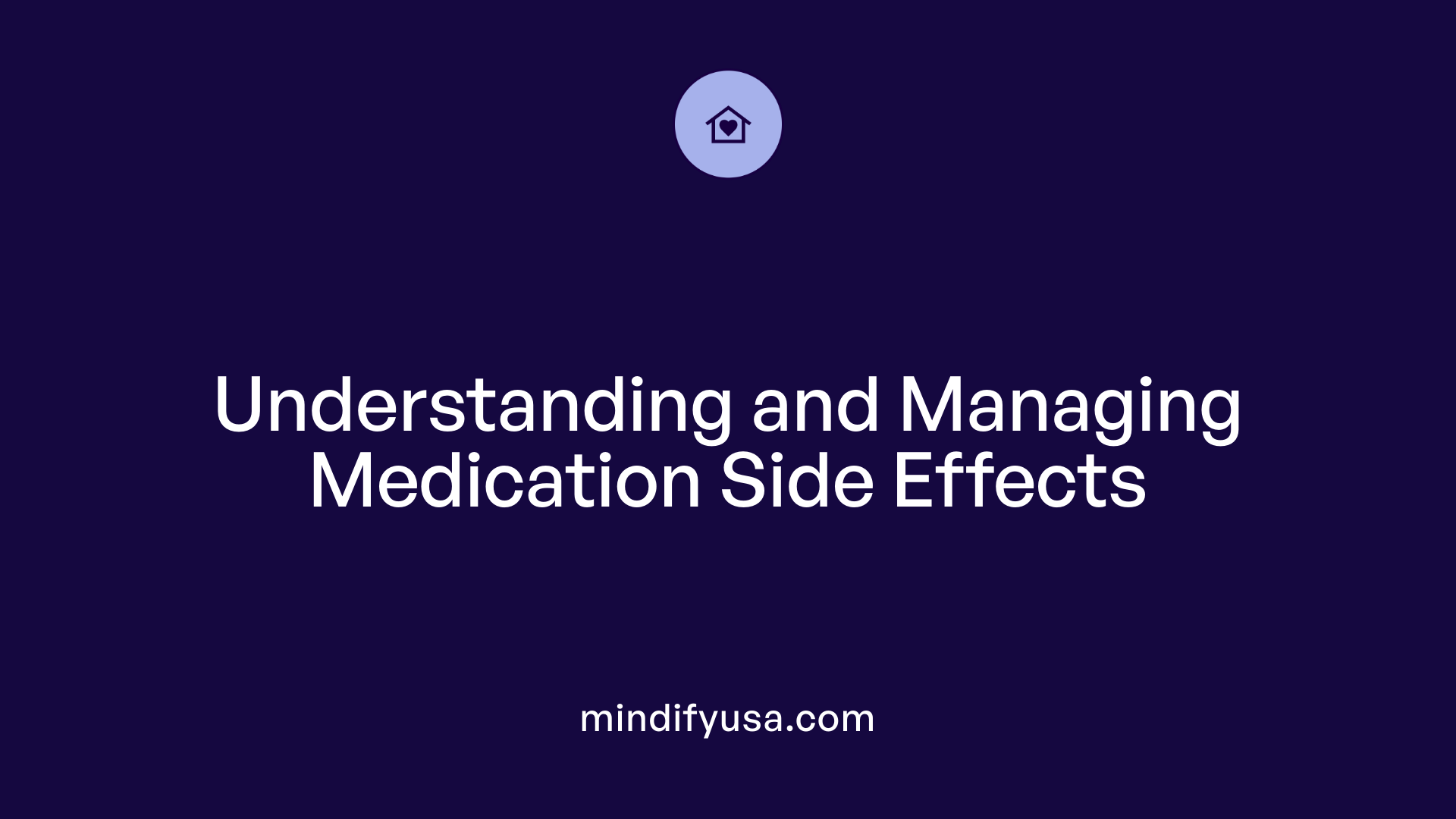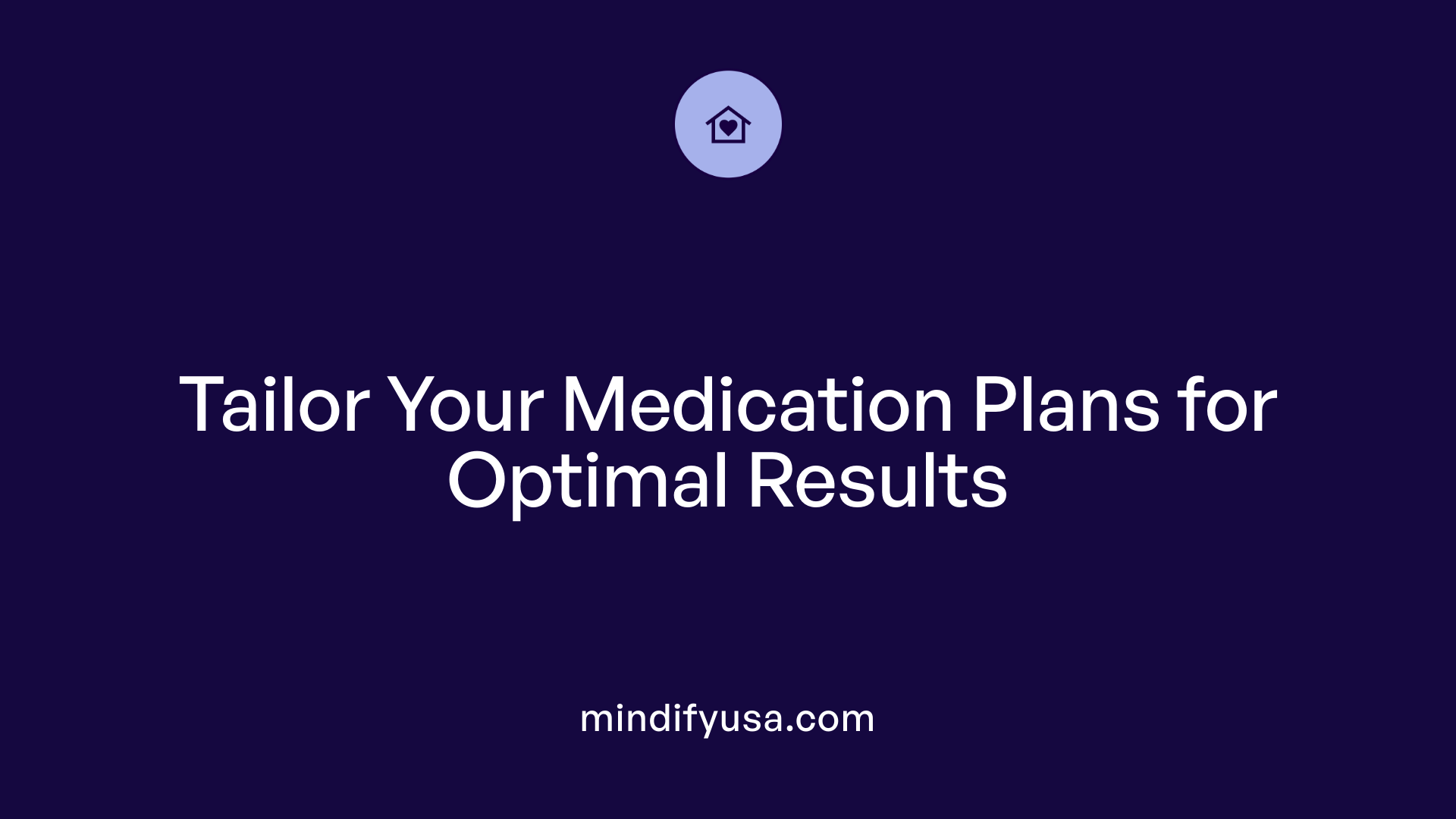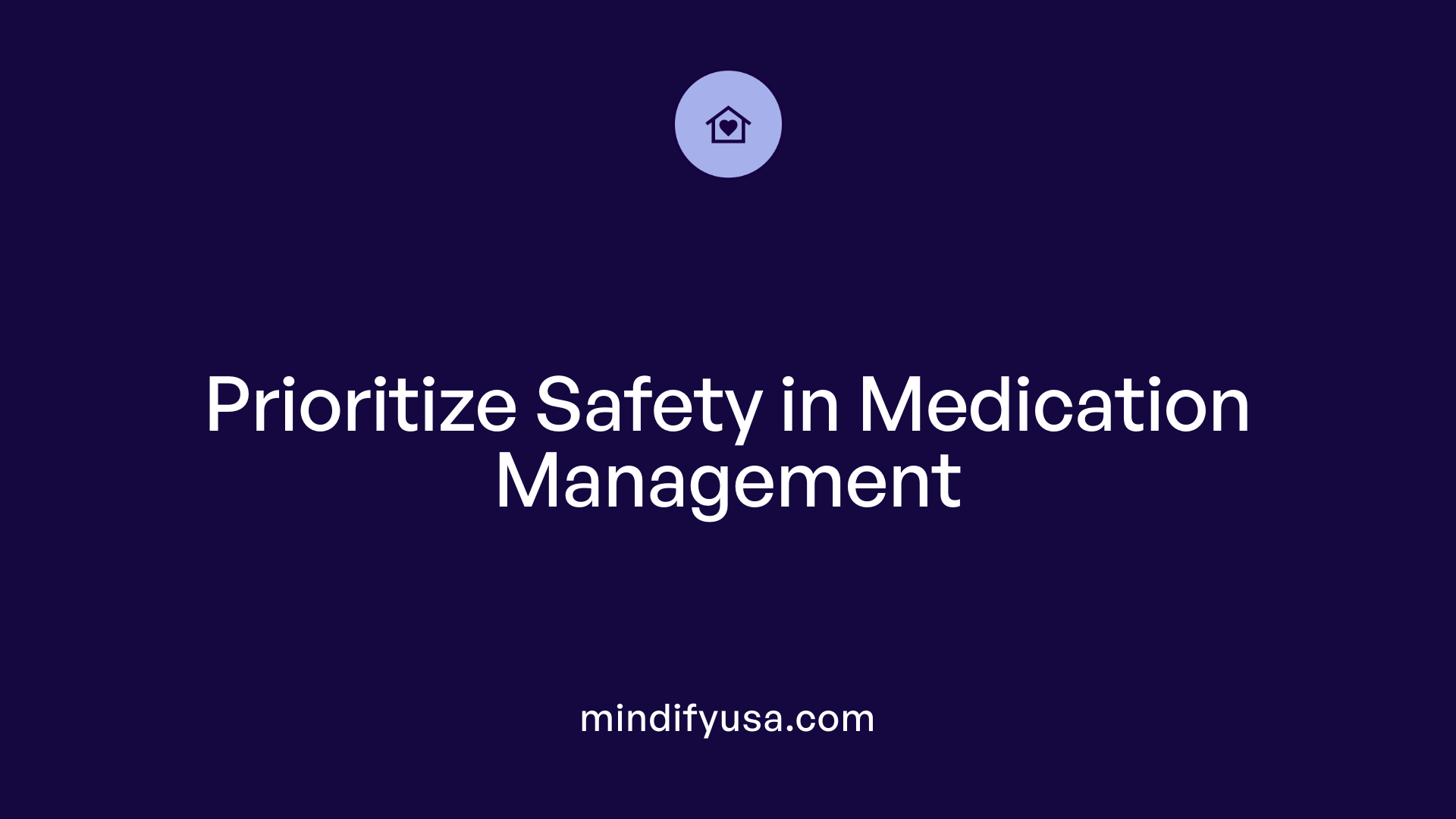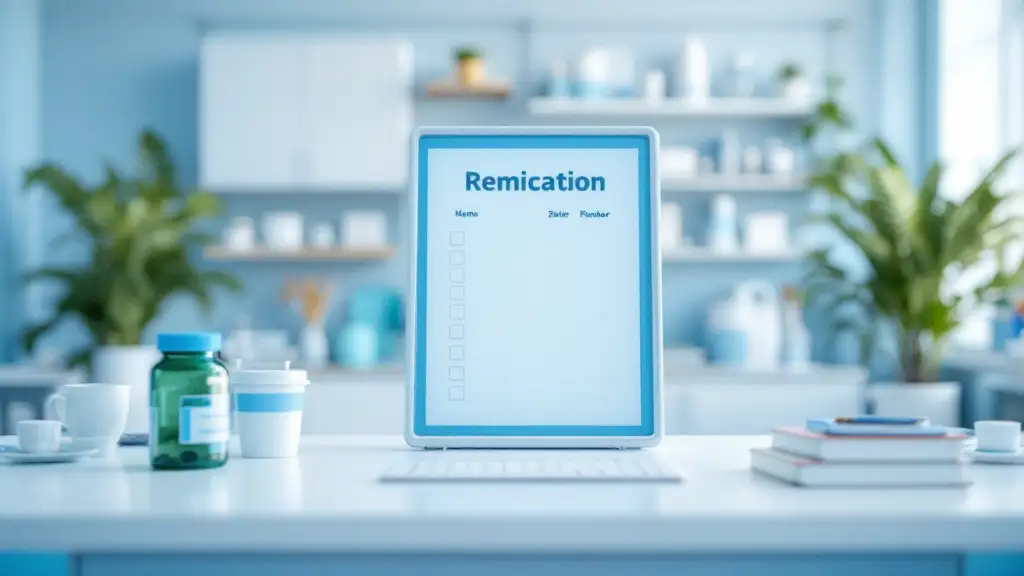Understanding and Navigating Medication Side Effects
Medication side effects are common but manageable aspects of modern pharmacotherapy. Effective adjustment plans require a proactive approach involving patient education, open communication with healthcare providers, and personalized treatment strategies. This article explores key insights into managing medication side effects, tailoring regimens, and ensuring safety to improve therapeutic outcomes.
Common Side Effects and Their Management

What are common side effects of medications and how can they be managed?
Medications can cause a variety of side effects, which depend on the type of drug, dosage, and individual differences. Common side effects include nausea, dizziness, drowsiness, stomach issues like diarrhea or constipation, weight changes, and allergic reactions. Some side effects are minor and temporary, while others may be more serious.
To manage mild side effects, patients are encouraged to follow prescribed instructions carefully. Adjusting the timing of doses, taking medications with food, avoiding alcohol, and maintaining hydration and nutrition can help. Keeping a medication journal to track symptoms can also guide treatment adjustments and improve outcomes.
Open communication with healthcare providers is essential. Patients should report any side effects, especially if they persist or worsen, as physicians may modify the dose, switch medications, or add supportive treatments. Proper storage of medicines in cool, dry places and reading medication labels are practical steps in minimizing side effects.
Severe or persistent side effects require immediate medical attention. Never stop or alter medications without consulting a healthcare professional, because abrupt changes can be harmful. Regular follow-up and consultations can help ensure treatment remains effective and safe.
In summary, awareness of potential side effects, prompt reporting, lifestyle modifications, and professional guidance are central to managing medication-related reactions effectively.
How to manage mild and severe side effects
Managing side effects involves tailored strategies based on severity. Mild reactions, such as slight stomach upset or fatigue, often improve over time or with dosage adjustments. Healthcare providers might recommend taking medication with food, changing the dosing schedule, or temporarily reducing the dose.
For severe side effects—such as difficulty breathing, severe allergic reactions, or signs of toxicity—immediate medical attention is necessary. Physicians may need to permanently change the medication or provide additional supportive therapy.
Patients should always work closely with their healthcare team, never attempt to self-treat severe reactions, and keep detailed records of their symptoms.
Importance of reporting persistent or severe reactions
Prompt reporting of side effects is vital for safe medication management. It helps healthcare providers decide whether to continue, modify, or discontinue a medication.
Patients are encouraged to use resources like the FDA’s MedWatch program to report adverse effects. Keeping open lines of communication ensures that side effects are managed effectively, minimizing risks and improving overall health outcomes.
Overall, managing medication side effects involves education, vigilance, and proactive partnership with healthcare professionals to support safe and effective treatment.
Effective Communication with Healthcare Providers

How can patients communicate effectively with healthcare providers about medication side effects?
Clear and open communication plays a vital role in managing medication side effects effectively. Patients should start by keeping a detailed record of any symptoms or adverse effects they notice, including how severe they are and how often they occur. This documentation helps healthcare providers understand what’s happening and makes it easier to determine whether adjustments are necessary.
During appointments, patients should openly share their records and express any concerns about side effects, especially if they are new, persistent, or bothersome. It’s important to discuss both common effects, such as nausea or drowsiness, and less common symptoms that might still impact quality of life.
Verbal conversations are essential, but supplementing them with written or digital tools provided by healthcare providers can help reinforce understanding. For example, using medication diaries or smartphone apps can keep track of symptoms over time.
Strategies like the teach-back method—where patients repeat back instructions to confirm understanding—or 'brown bag' reviews—where patients bring all medications to appointments for review—can greatly improve communication. These approaches ensure that patients understand their medication plan, recognize side effects early, and know when to seek help.
Moreover, patients are encouraged to ask specific questions about potential side effects from their doctor or pharmacist. Questions might include what effects are most common, which symptoms need urgent attention, and what modifications can be made if troublesome side effects occur.
Ultimately, effective dialogue and proactive engagement foster safer, more personalized medication management, leading to better health outcomes and fewer avoidable complications.
Strategies for Personalizing and Adjusting Medication Plans

What strategies can be used to adjust medication plans to reduce side effects?
Adjusting medication plans to minimize side effects involves several practical strategies. Healthcare providers often start by customizing the dosage based on individual factors such as age, weight, kidney and liver function. This personalized approach ensures medications are both effective and safe for each patient.
Regular medication reviews and reconciliation are crucial. These processes help identify any unnecessary or duplicate therapies, which can then be deprescribed, especially in older adults who often take multiple medicines.
Tools like pill organizers, smartphone reminders, and adherence apps support proper medication intake. These tools help prevent missed doses or accidental overdoses, reducing the risk of side effects caused by inconsistent use.
Open communication with healthcare providers is also vital. Sharing experiences and side effects promptly can lead to timely dose adjustments or switching to alternative medications that cause fewer adverse effects. Continuous monitoring and follow-up further ensure that the medication remains safe and effective over time.
Collaboration with pharmacists and utilizing evidence-based decision support systems can optimize treatment plans. These efforts help tailor medications closely to the patient's specific health needs and lifestyle, improving overall outcomes.
Personalization of Medication Regimens through Scientific Advances
How can medication regimens be personalized to enhance safety and effectiveness?
Personalized medicine is transforming healthcare by allowing treatments to be tailored to each individual’s unique biological makeup. This approach involves integrating a wide range of scientific data, including genetic, genomic, proteoform, and other molecular information. By understanding the specific disease mechanisms and treatment responses unique to each patient, clinicians can optimize medication choices.
Recent advances in artificial intelligence (AI) and sophisticated data analysis tools enable healthcare providers to interpret complex datasets effectively. These datasets include genetic test results, proteomics (the study of proteins and their variations), and electronic health records (EHRs). These technologies assist in creating a comprehensive picture of how an individual may respond to specific drugs.
One prominent example of personalization is pharmacogenomics. This field studies how genetic variations influence drug response. For example, certain genetic markers can predict whether a patient will metabolize a medication quickly or slowly, guiding clinicians to select the appropriate dose or alternative therapy. This reduces the risk of adverse effects and increases treatment success.
In addition to genetic data, understanding proteoforms—varieties of proteins resulting from genetic and post-translational modifications—helps in designing targeted drugs. These treatments can specifically address molecular differences impacting disease pathways, improving both safety and efficacy.
Overall, scientific progress and technological innovations are enabling a shift toward safer, more effective treatments. Personalized treatment plans that leverage these advancements promise better health outcomes and minimized side effects, marking a new era of precision medicine.
Educational Resources and Support for Medication Management
 Patients have access to a wide array of educational tools and materials designed to enhance their understanding of medications and improve management skills. Healthcare providers often provide personalized guidance during appointments, explaining how to take medications correctly and what side effects to watch for. Written materials such as medication leaflets, labels, and instructions offer detailed information that patients can review at their convenience.
Patients have access to a wide array of educational tools and materials designed to enhance their understanding of medications and improve management skills. Healthcare providers often provide personalized guidance during appointments, explaining how to take medications correctly and what side effects to watch for. Written materials such as medication leaflets, labels, and instructions offer detailed information that patients can review at their convenience.
Furthermore, reputable websites such as SafeMedication.com, along with resources from organizations like the American Society of Health-System Pharmacists (ASHP) and the Agency for Healthcare Research and Quality (AHRQ), provide extensive information. These include medication safety guides, detailed drug monographs, and digital tools that help track doses and symptoms.
Resources are also customized for specific groups, including older adults, caregivers, and parents. These materials often highlight best practices for safe medication use, recognizing potential interactions, and managing side effects.
Support tools play a vital role in medication management. Patients are encouraged to keep comprehensive medication lists, including prescriptions, over-the-counter medicines, vitamins, and supplements. Wallet cards with this information simplify sharing details with healthcare providers. Proper disposal procedures for expired or unused medicines help prevent accidental ingestion and harm.
Overall, these educational resources and support tools empower patients to participate actively in their treatment, leading to safer medication use and better health outcomes.
Ensuring Safety in Medication Management and the Role of Therapy Programs

What safety considerations should be taken into account when managing medications?
Managing medications safely requires careful attention to several factors. Healthcare providers must verify the correct dosage, ensure clear documentation of patient information, allergies, and medication histories, and be vigilant against potential drug interactions and adverse reactions. Standardized prescribing and dispensing practices, such as including the medication's purpose and patient weight, help avoid errors.
Technology plays a vital role in safety. Electronic health records, barcode verification systems, and error reporting tools can detect and prevent mistakes, particularly with high-risk drugs or during care transitions.
Proper medication storage and labeling are equally important. Medications should be stored in child-proof containers, labeled clearly, and kept in safe, dry, and cool locations away from hazards.
Staff education, patient involvement, and adherence to guidelines from organizations like the Institute for Safe Medication Practices (ISMP) help minimize errors and prevent adverse drug events.
What role do medication therapy management programs play in mitigating side effects?
Medication therapy management (MTM) programs are essential in reducing side effects and improving medication safety. These programs involve licensed pharmacists who review all medications a patient takes—including prescriptions, over-the-counter drugs, and supplements—to identify potential interactions and safety concerns.
By conducting regular comprehensive reviews, MTM helps detect adverse drug reactions early on. Pharmacists work closely with healthcare providers to optimize medication choices, adjust doses, or suggest alternatives tailored to the patient's needs.
Patient education is a core component. MTM programs provide counseling to help patients understand their medications, adhere properly, and recognize side effects that should be reported.
Through these collaborative efforts, MTM programs reduce medication-related hospitalizations, enhance treatment outcomes, and significantly bolster patient safety.
| Aspect | Description | Additional Details |
|---|---|---|
| Safety Measures | Dosage verification, error reporting systems | Use of electronic records and barcode systems |
| Patient Engagement | Education, adherence | Counseling on side effects and proper use |
| Healthcare Collaboration | Regular reviews, adjustments | Team approach including pharmacists and providers |
| Storage & Handling | Proper storage, labeling | Childproof containers, safe locations |
| Technology & Guidelines | Error prevention tools | Follow ISMP and FDA standards |
Focusing on thorough safety practices and regular medication reviews through programs like MTM can significantly enhance medication safety, prevent errors, and improve overall health outcomes.
Prioritizing Safety and Personalization in Medication Adjustment
Effective medication side effect adjustment plans are essential for ensuring patient safety, improving adherence, and optimizing therapeutic outcomes. By fostering open communication, leveraging scientific advances, providing educational resources, and utilizing comprehensive medication management programs, healthcare providers and patients can work together to navigate side effects efficiently. Personalization, vigilant safety practices, and continuous monitoring form the cornerstone of a successful medication adjustment strategy, ultimately leading to safer, more effective healthcare tailored to individual patient needs.
References
- How To Manage Side Effects During Medication ...
- 6 tips for managing common medication side effects
- How to Deal With Side Effects of Medicine
- Medication Adherence and Compliance: Recipe for ...
- 6 top tips for adjusting to new medication
- Medications as part of a treatment plan
- Medication Management and Safety Tips





































































































